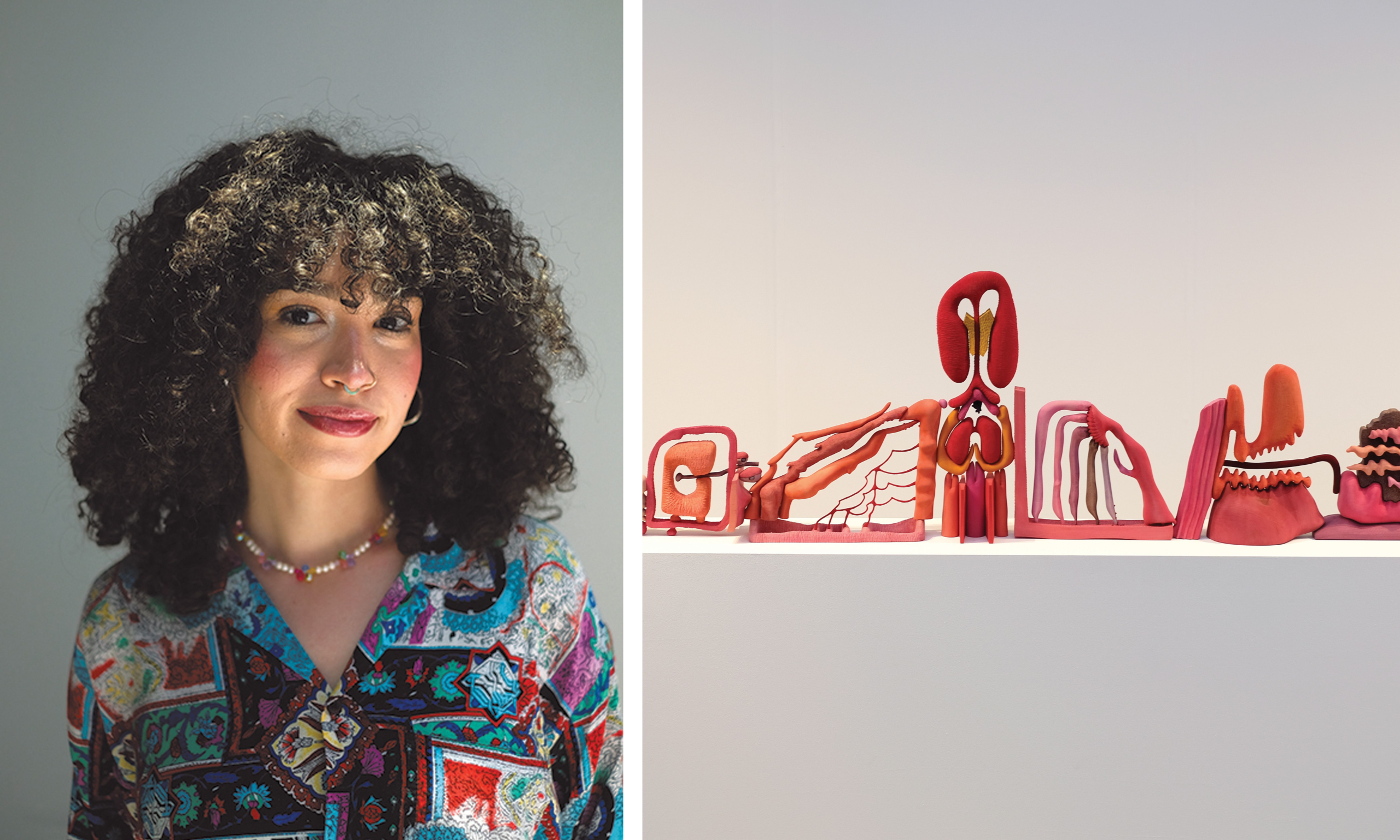Angelik Vizcarrondo-Laboy (left) with one of her favourite works at Frieze New York, Matthew Ronay's The Crack, the Swell, an Earth, an Ode (2022) at Casey Kaplan gallery
Photos: Alex Wroblewski
Angelik Vizcarrondo-Laboy, a Los Angeles-based curator and contemporary craft writer, is the creative mind behind Funk You Too! Humor and Irreverence in Ceramic Sculpture, a radical ceramics show on view at the Museum of Art and Design in New York. Born and raised in Puerto Rico, her consistent elevation of marginalised artists informs her fresh curatorial eye, which highlights voices and aesthetics often sidelined by the mainstream art world.
Vizcarrando-Laboy has curated The Universe Within at Mindy Solomon Gallery in Miami, an exhibition celebrating diasporic Black subjectivity; and Belonging, the 2022 NCECA Annual Exhibition at the Crocker Art Museum in Sacramento, California, which explored the notion of true inclusion in the American mythos. The Art Newspaper caught up with Vizcarrondo-Laboy to find out her favourite works at Frieze New York.
Photo: Alex Wroblewski
“I think glass is a really hard medium; it’s really technically challenging. There’s an expectation of virtuosity sometimes that I find to be too traditional, but with Kelly, the combination of hard and soft—the juxtaposition is incredible. It’s also notable that bare hands can’t actually touch glass during the process of making it, so it’s really cool that they’re placed together in that way.”
Photo: Alex Wroblewski
“I love the structure of it, how there’s all this negative space in this tower that feels a little shaky, and there’s the mixed media moment happening on top. But the palm trees always get me. It’s a very abstract piece over all, but the artist has included these super recognisable elements. It feels quirky, in a way, there’s a humour to it. Even though it’s out of place, it’s my favourite part of the piece.”
Photo: Alex Wroblewski
“Painting for me is hard, since I’m coming from a more dimensional background, but her work feels so mythical, I really like the transcendental quality of it. It feels very Millennial to me. I feel like there’s something going on with the way the bodies and the elements are rendered that feels very now and of the moment, also very young. I love thinking about the way the fire is interpreted in the paintings, it’s really beautiful.”
Photo: Alex Wroblewski
“Since I come from a craft background, I love this. This is all wood—he’s whittling these pieces of wood down into such insane shapes, especially the really thin moments. It can’t be easy to do. I think there’s something moody and bodily about it, it looks very guttural, but really beautiful, especially with the tones he’s picking. He’s taken so many pieces and created such a long display—I’ve seen his work before, and it’s usually smaller, single pieces.”
Photo: Alex Wroblewski
“This woman is an icon. You know how the kids say ‘mother’? She’s ‘mother’. She’s an icon in terms of the Craft movement in the US, so it’s cool to see her work in this context. Basically, she makes giant fibre vaginas! She was a part of Woven Forms, the 1963 show at the Museum of Contemporary Crafts, right next door to MoMA, which was a big historical deal. This piece is a vintage; it’s so cool to see older work recontextualised in this setting that’s usually about what’s the newest and latest. Her work deserves attention.”
Photo: Alex Wroblewski
“I’ve gotten to work with Sharif before; I’ve watched his career grow since he was doing his BFA in California. This is actually from his MFA show he just did. I love his work, it’s fun, and it really says California to me. It’s funny, but also technically amazing. I feel like during his MFA his work has really crystallised, you can see it in the little details throughout.”
Photo: Alex Wroblewski
“She’s from California, so her work is very much about her community, her people. She just did the rooftop commission at the Metropolitan Museum of Art, so she’s taking these ancient images and bringing them into a contemporary moment. It’s like a mixture of 1990s Egyptian information and the now—hieroglyphs as a form of graffiti. I love the idea of creating artefacts for the future, especially from a Black perspective.”
Photo: Alex Wroblewski
“I love the way he’s playing with the presumed neutrality of the thread. It’s embroidered in a way that’s really loose, so he’s making a painting of sorts, there’s a lot of dynamism to it. I love the way he’s using colour, and I like how there’s a more traditionally embroidered piece at the bottom, and the more rare, stunning narrative depiction on the top. I love textiles, so it’s great seeing them represented this way.”

